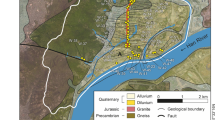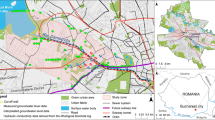Abstract
In the northwestern area of Basel, Switzerland, a tunnel highway connects the French highway A35 (Mulhouse–Basel) with the Swiss A2 (Basel–Gotthard–Milano). The subsurface highway construction was associated with significant impacts on the urban groundwater system. Parts of this area were formerly contaminated by industrial wastes, and groundwater resources are extensively used by industry. During some construction phases, considerable groundwater drawdown was necessary, leading to major changes in the groundwater flow regime. Sufficient groundwater supply for industrial users and possible groundwater pollution due to interactions with contaminated areas had to be taken into account. A groundwater management system is presented, comprising extensive groundwater monitoring, high-resolution numerical groundwater modeling, and the development and evaluation of different scenarios. This integrated approach facilitated the evaluation of the sum of impacts, and their interaction in time and space with changing hydrological boundary conditions. For all project phases, changes of the groundwater system had to be evaluated in terms of the various goals and requirements. Although the results of this study are case-specific, the overall conceptual approach and methodologies applied may be directly transferred to other urban areas.
Résumé
Au nord-ouest de Bâle, en Suisse, un tunnel-autoroutier connecte l’autoroute française A35 (Mulhouse-Bâle) avec l’autoroute suisse A2 (Bâle-Gotthard-Milan). La construction de la chaussée a été associée à des impacts significatifs sur le système urbain d’eau souterraine. Des parties de la zone avaient été auparavant contaminées par des déchets industriels, et les ressources en eau souterraine sont intensivement utilisées par l’industrie. Durant certaines phases de la construction, un rabattement très important a été nécessaire, conduisant à des changements importants du régime d’écoulement de l’eau souterraine. Une alimentation suffisante en eau souterraine pour les industriels et une pollution possible de l’eau souterraine du fait d’interactions avec des zones contaminées ont du être pris en compte.Un système de gestion de l’eau souterraine est présenté, comprenant un système étendu de surveillance de l’eau souterraine, un modèle hydrogéologique de haute résolution, et le développement et l’évaluation de différents scénarios. Cette approche intégrée a aidé à évaluer l’ensemble des impacts, et leur interaction dans le temps et l’espace avec les variations des conditions hydrologiques aux limites. Pour toutes les phases du projet, les changements du système eau souterraine ont du être évalués, au regard des divers buts et nécessités. Bien que les résultats de cette étude sont spécifiques à ce projet, l’approche conceptuelle globale et les méthodes appliquées pourraient être transférées directement à d’autres zones urbaines.
Resumen
En el área del noroeste de Basilea, Suiza, un túnel de carretera conecta la carretera francesa A35 (Mulhouse–Basilea) con la A2 suiza (Basilea–Gotthard–Milano). La construcción subsuperficial de la carretera estuvo ligada con impactos significativos sobre el sistema de agua subterránea urbano. Algunas partes de esta área fueron contaminadas anteriormente por desechos industriales, y los recursos de agua subterránea son usados ampliamente por la industria. Durante algunas fases de la construcción fue necesario crear abatimientos considerables del agua subterránea, generando cambios mayores en el régimen del flujo del agua subterránea. Debieron ser tenidos en cuenta tanto un abastecimiento suficiente con agua subterránea para los usuarios industriales, como también la posible contaminación del agua subterránea debido a las interacciones con las áreas contaminadas. Se presenta un sistema de gestión de agua subterránea, incluyendo un monitoreo extenso de esta misma, modelamiento numérico de resolución alta para el agua subterránea, y el desarrollo y evaluación de escenarios diferentes. Este acercamiento integrado facilitó la evaluación del total de impactos, y de su interacción en el tiempo y espacio con las condiciones cambiantes en los límites hidrológicos. Para todas las fases del proyecto, los cambios del sistema del agua subterránea tuvieron que ser evaluados en términos de las metas y requisitos variados. Aunque los resultados de este estudio son específicos del caso, pueden transferirse directamente a otras áreas urbanas, tanto el acercamiento conceptual global, como las metodologías aplicadas.












Similar content being viewed by others
References
Aldrick RJ, Rivett MO, Hepburn SL (1999) Urban groundwater and environment management: Hull, east Yorkshire. In: Chilton J (ed) Groundwater in the urban environment: selected city profiles. Balkema, Lisse, The Netherlands, pp 91–96
Altshuler A, Luberoff D (2003) Mega-projects: the Changing Politics of Urban Public Investment. Brookings, Washington, DC
Bedford B (1996) The need to define hydrologic equivalence at the landscape scale for freshwater wetland mitigation. Ecol Appl 6:57–68
Chiang WH (2005) 3D-Groundwater Modeling with PMWIN: a simulation system for modeling groundwater flow and transport processes, 2nd edn. Springer, Berlin
Chilton J, Hiscock K, Younger P, Morris B, Puri S, Nash H, Aldous P, Tellam J, Kimblin R, Hennings S (eds) (1997) Groundwater in the urban environment: problems, processes and management. 27th Congr. Int. Assoc. Hydrogeologists (IAH), 21–27 Sept 1997, Nottingham, Balkema, Lisse, The Netherlands
EEA (1999) Environment in the European Union at the turn of the century. European Environment Agency, Copenhagen, Denmark
Eiswirth M (2001) Hydrogeological factors for sustainable urban water systems. In: Howard K, Israfilov R (eds) Current problems of hydrogeology in urban areas, urban agglomerates and industrial centers. Kluwer, Dordrecht, The Netherlands, pp 159–183
Eiswirth M, Hötzl H, Cronin A, Morris B, Veselič M, Bufler R, Burn S, Dillon P (2003) Assessing and improving sustainability of urban water resources and systems. RMZ Mater Geoenviron 50:117–120
Eiswirth M, Wolf L, Hötzl H (2004) Balancing the contaminant input into urban water resources. Environ Geol 46:246–256
Ellis B (ed) (1999) Impacts of urban growth on surface water and groundwater quality. IAHS 259, IAHS, Wallingford, UK
Eyles E (ed) (1997) Environmental geology of urban areas. Spec. Publ. 3, Geological Association of Canada, London, ON
Fatta D, Naoum D, Loizidou M (2002) Integrated environmental monitoring and simulation system for use as a management decision support tool in urban areas. J Environ Manage 64:333–343
Foster SSD (2001) The interdependence of groundwater and urbanization in rapidly developing cities. Urban Water 3:185–192
Gossell W, Herfert J, Chowanietz U, Hermel U (1999) Sustainable groundwater management for the Berlin region. In: Chilton J (ed) Groundwater in the urban environment: selected city profiles. Balkema, Lisse, The Netherlands, pp 139–143
GSchG (1991), Bundesgesetz über den Schutz der Gewässer, 814.20 (Federal Law for the Protection of Water Bodies, 814.20)
GSchV (1998) Gewässerschutzverordnung, 814.201 (Federal Law for the Protection of Water Bodies, 814.201)
Harbaugh AW, Banta ER, Hill MC, Mc Donald MG (2000) Modflow-2000: the US geological survey modular ground-water model-user guide to modularization concepts and the ground-water flow process. US Geol Surv Open-File Rep 00–92
Howard KF (2006) Urban groundwater: meeting the challenge. IAH selected paper series, Taylor & Francis, London
Howard KWF, Israfilov R (2002) Current problems of hydrogeology in urban areas, urban agglomerates and industrial centers. Kluwer, Dordecht, The Netherlands
Hufschmied P (2006) Hydrogeological and geotechnical problems during construction of traffic lines in Central Berlin. Presentation at the Swiss Hydrogeological Society, Geneva, 12–13 May 2006
Huggenberger P (1999) Urban geology: the example groundwater (in German). Uni Nova April 99, Basel, Switzerland
Huggenberger P, Epting J, Spottke I, Regli C, Zechner E (2006) Fluss-Grundwasser-Interaktion, Interreg III Projekt A MoNit: Modellierung der Grundwasserbelastung durch Nitrat im Oberrheingraben, Landesamt für Umwelt, Messungen und Naturschutz Baden-Württemberg, Karlsruhe [River-groundwater-interaction, Interreg III Project A MoNit: modeling of nitrate impact to the groundwater in the upper Rhine graben]. Engelhart & Bauer, Karlsruhe, Germany
Lerner DN (1996) Guest editor’s preface: theme issue on urban groundwater. Hydrogeol J 4:4–5
Lerner DN (2003) Urban groundwater pollution. International contributions to hydrogeology, ICH 24. IAH, Taylor & Francis, London
Moench AF (1997) Flow to a well of finite diameter in a homogeneous, anisotropic water table aquifer. Water Resour Res 33:1397–1407
National Research Council (1990) Groundwater models: scientific and regulatory applications. National Academy Press, Washington, DC
National Research Council (1992) Global environmental change.: understanding the human dimensions. Stern PC, Young OR, Druckman D (eds) Committee on the Human Dimensions of Global Change; Commission on Behavioral and Social Science and Education. National Academy Press, Washington, DC
Neuman SP (1974) Effect of partial penetration on flow in unconfined aquifers considering delayed gravity response. Water Resour Res 10:303–312
Pahl-Wostl C (2006) NeWater Newsletter No. 1: new Approaches to Adaptive Water Management under Uncertainty. NeWater at the World Water Forum in Mexico. Mexico City, March 2006, http://www.newater.info. Cited June 2006
Pahl-Wostl C, Möltgen J, Sendzimir J, Kabat P (2005) New methods for adaptive water management under uncertainty–the NeWater project. Paper accepted for the EWRA Conference 2005, Menton, France, September 2005
Prokop G (2003) Sustainable management of soil and groundwater resources in urban areas. Proceedings of the 2nd IMAGE-TRAIN Cluster Meeting, Krakow, Poland, 2–4 Oct 2002
SGH (Swiss Hydrogeological Society) (2006) Urban Hydrogeology (in German and French). Spring time conference on Urban Hydrogeology, Geneva, Switzerland, 12 May 2006
Vázquez-Suñé E, Sánchez-Vila X, Carrera J (2005) Introductory review of specific factors influencing urban groundwater, an emerging branch of hydrogeology, with reference to Barcelona, Spain. Hydrogeol J 13:522–533
Wagner U, Huggenberger P, Schaub D, Thater M (2001) Interreg III: Erkundung der Grundwasserleiter und Böden im Hochrheintal [Interreg III: investigation of the aquifers and soils in the Hochrheintal]. Landratsamt Waldshut, Waldshut, Germany, 101 pp
Wolf L, Morris B, Burn S (2006) AISUWRS Urban Water Resources Toolbox: integrating groundwater into urban water management. IWA, London
Acknowledgements
We thank Manfred Epting and Eric Barnsley for reviewing the manuscript as well as the editors and two anonymous reviewers who provided valuable comments.
Author information
Authors and Affiliations
Corresponding author
Rights and permissions
About this article
Cite this article
Epting, J., Huggenberger, P. & Rauber, M. Integrated methods and scenario development for urban groundwater management and protection during tunnel road construction: a case study of urban hydrogeology in the city of Basel, Switzerland. Hydrogeol J 16, 575–591 (2008). https://doi.org/10.1007/s10040-007-0242-5
Received:
Accepted:
Published:
Issue Date:
DOI: https://doi.org/10.1007/s10040-007-0242-5




